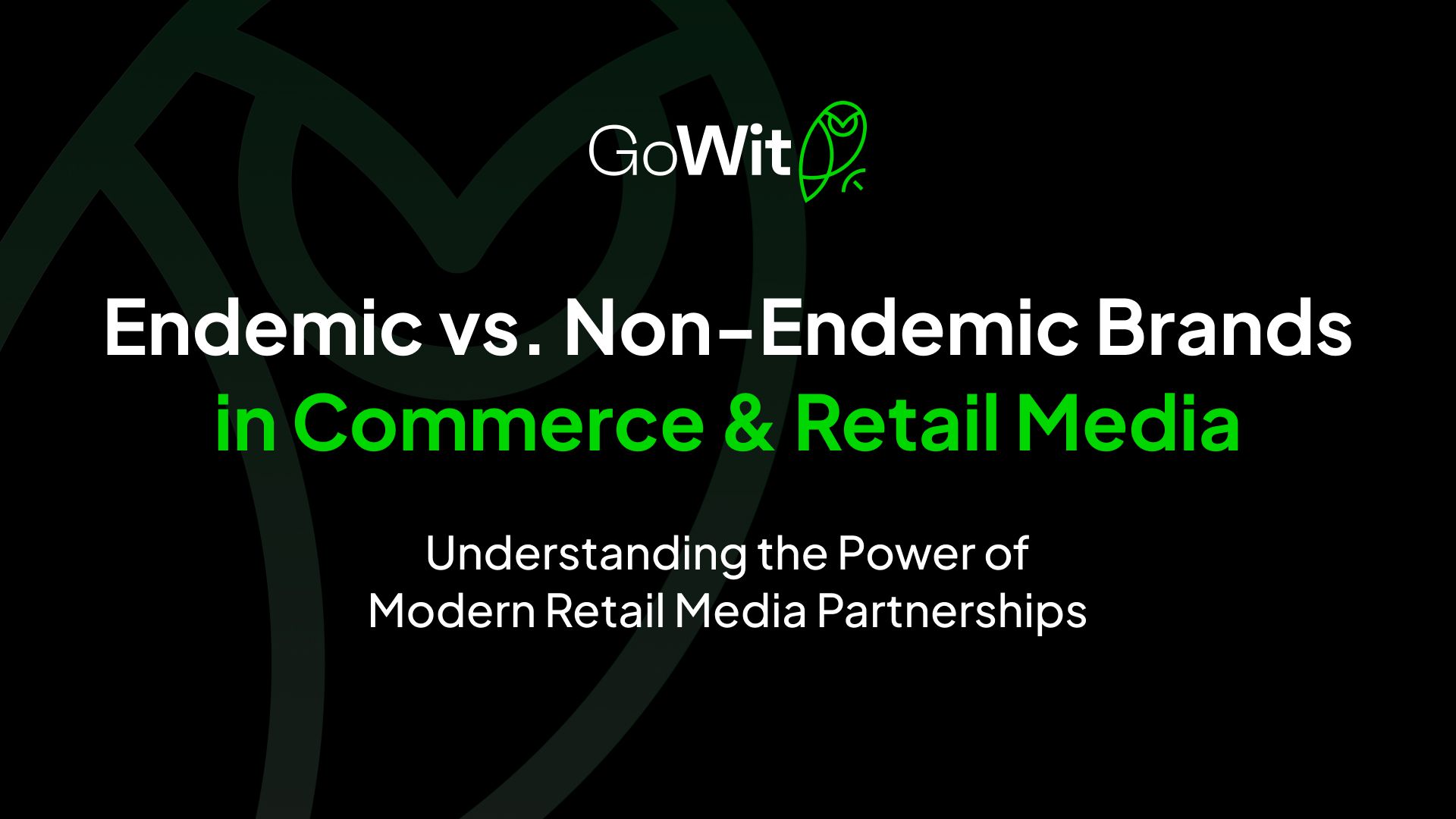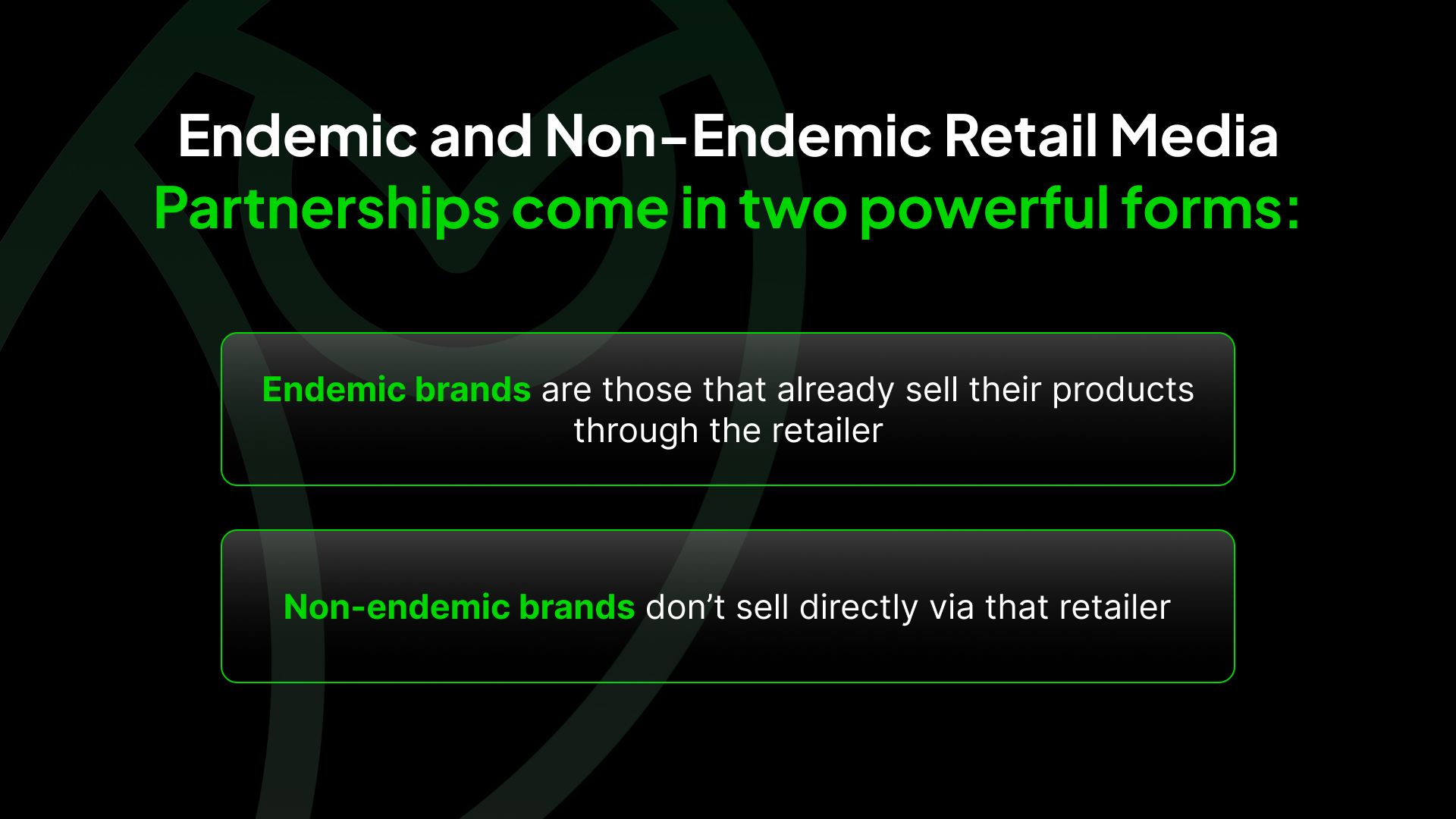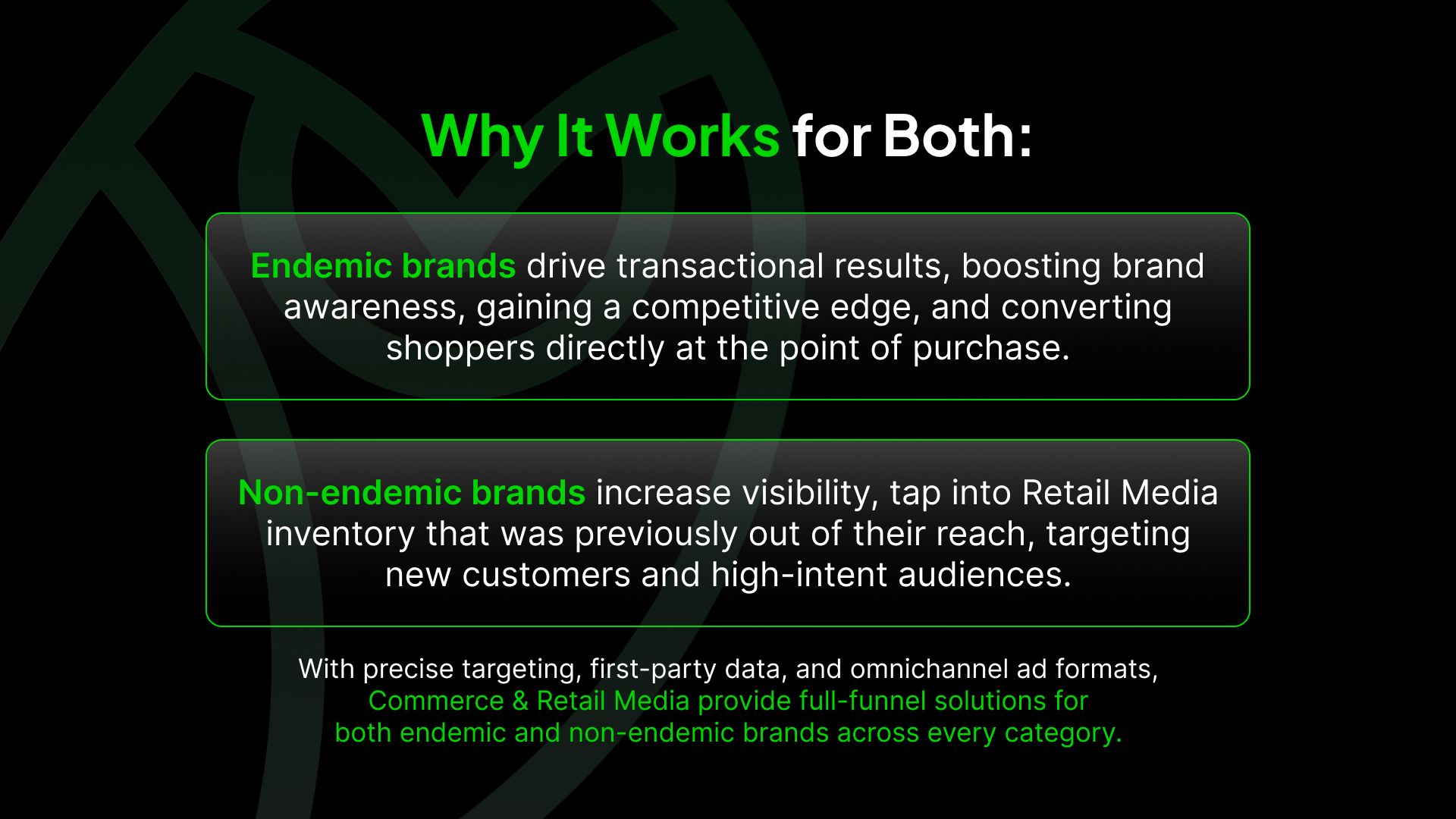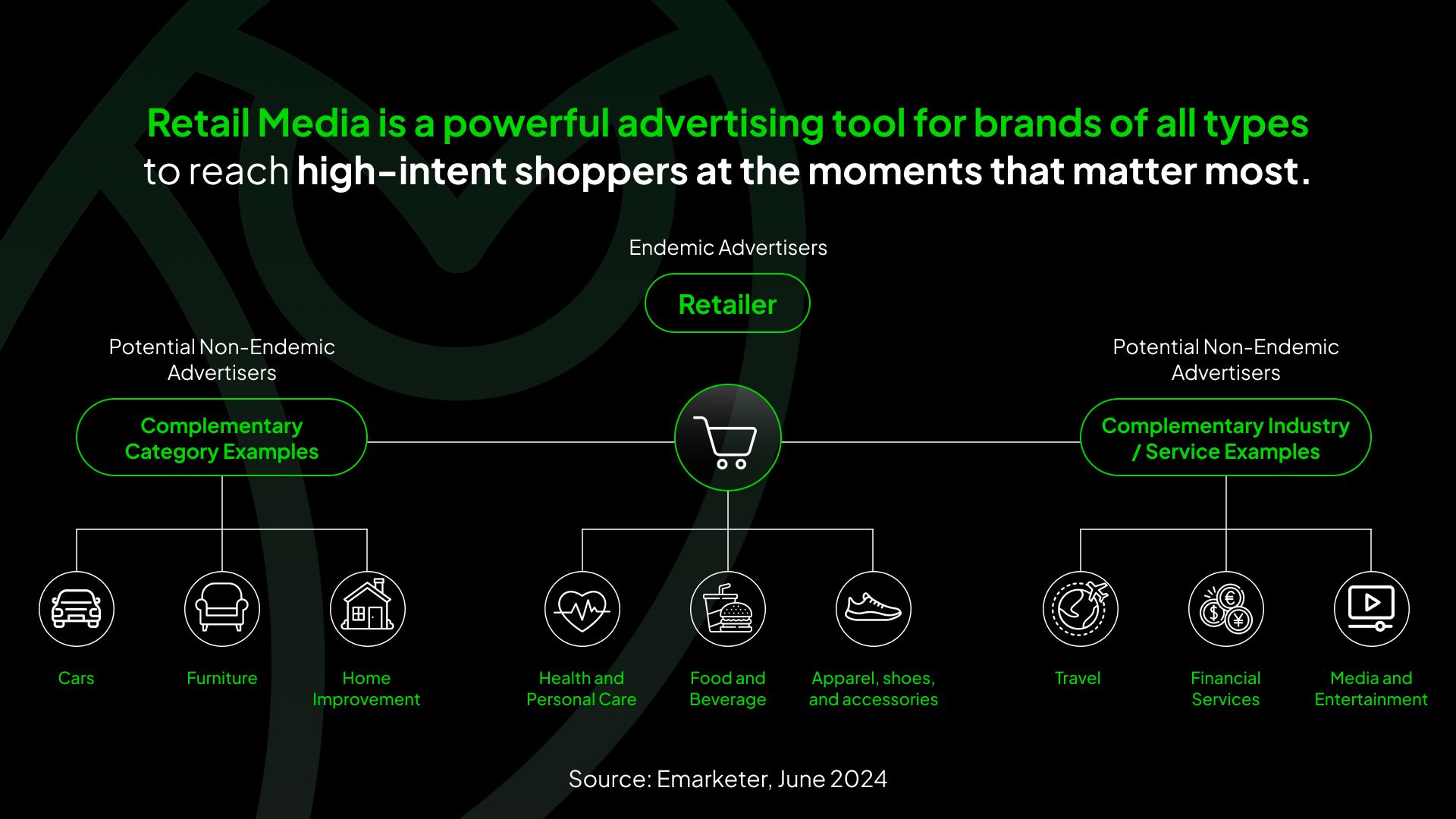Endemic vs. Non-Endemic Brands in Commerce & Retail Media
Brands
.
5 min read
“Discover how endemic and non-endemic brands can unlock growth through Retail Media and Commerce Media. Learn proven strategies, see real-world performance data, and explore expert insights from eMarketer, Publicis Commerce, M3, and Guideline.”

Retail Media is a transformative channel reshaping how brands connect with high-intent shoppers. As this space evolves intoCommerce Media, it opens new doors for bothendemic and non-endemic brandsto access precision targeting, closed-loop measurement, and omnichannel impact.
But what exactly do these terms mean, and why do these partnerships matter?
Let’s break it down in this blog.
What Are Endemic and Non-Endemic Brands?
At its core, the distinction comes down towho is selling what and where. Endemic brandsare those that sell their products directly through the retailer. For example, a beverage brand promoting its product on a supermarket’s website or an electronics manufacturer running ads on a tech retailer's app. These are straightforward commerce-driven relationships. The retailer sells the product, the brand pays for visibility, and the result is typically a highly transactional ad experience.
By contrast,non-endemic brandsdo not sell through the retailer’s platform but still advertise within that retail environment. A travel company advertising on a fashion e-commerce site or a telecom provider running campaigns through an online grocery platform are classic examples of non-endemic activation. These brands are not trying to sell their products in the cart, they’re trying to tap into theattention and contextthat retail environments uniquely provide.
The key distinction comes down to this: endemic brands are activating Retail Media Networks (RMNs) todrive immediate sales, while non-endemic brands are using it tobuild awareness, relevance, and engagementwith a high-intent audience.

Join to get free updates every week
Why These Partnerships Work
What makes both endemic and non-endemic brand participation in RMNs so valuable is the unique environment retailers offer: highly qualified traffic, commercial intent, and rich first-party data.
For endemic brands, Retail Media provides the most direct path from impression to transaction. These brands can reach shoppers right when they are browsing relevant categories or searching for products they already intend to buy.
Sponsored products, Sponsored Display, Video Ads, PDP (product detail page) placements give endemic advertisers an efficient, performance-driven way to convert traffic into revenue. In this context, RMNs act as a full-funnel performance engine, from discovery to purchase, all within the same ecosystem.
Non-endemic brands, while not selling directly through the retailer, still benefit enormously from being present in these environments. Retailers have amassed enormous volumes of first-party data, purchase history, product preferences, behavioral insights which can be used to precisely target audiences in a privacy-compliant way.
Non-endemic advertisers can access these environments to reach specific segments at scale, in a brand-safe and trusted setting. A bank may want to reach high-value tech buyers, or a streaming service may want to target young parents shopping on a children’s product site. Retail Media makes those touchpoints actionable.
Non-endemic brand participation is not just theoretical, it’s already happening at scale. In fact, according to research by Sarah Marzano in EMARKETER(July 2024), more than 53% of U.S. advertisers have partnered with retailers where they are a non-endemic brand, often leveraging the retailer’s first-party data and media network to reach valuable audiences. This illustrates just how compelling retail environments are, even for brands that don’t sell products through those channels.
As Stephen Mallouh, Commerce Manager at Publicis Commerce, notes, “Consumers don’t browse in silos… The attention is there. The traffic is there. The intent is there.” He emphasizes that retail platforms are high-intent, high-volume environments, making them a natural fit for non-endemic advertisers, even if the category isn’t directly related. When the context makes sense, relevance can be built beyond your traditional vertical, powered by the goldmine of clean, consented first-party data RMNs offer.
Performance proof backs this up. In a study conducted by Greg Stellato at M3 earlier this year, a non-endemic brand ran ads within a retail environment without any offer or retargeting and achieved 2.3X higher brand recall and a 64% lift in purchase intent. The results came purely from the right timing, placement, and context, underscoring the power of well-executed non-endemic Retail Media campaigns.
Moreover, non-endemic brands often find these placements less competitive and more contextually rich than traditional programmatic display. Because the audiences are curated and the formats are commerce-aligned, their campaigns deliver stronger engagement and better return on investment.

Commerce Media: Expanding the Playing Field
The evolution of Retail Media into Commerce Media is another factor accelerating the growth of both endemic and non-endemic opportunities. Commerce Media extends the reach of RMNs beyond the website or app into social platforms, CTV, influencer content, in-store digital displays, and even delivery apps or loyalty programs. It connects online and offline retail experiences and enables full-funnel, omnichannel storytelling.
For endemic brands, this evolution means more ways to stay top-of-mind, whether shoppers are on a product page, watching connected TV, or receiving a personalized email. For non-endemic brands, it opens the door to previously untapped environments where intent meets attention.
How Retailers Benefit
For retailers, embracing both endemic and non-endemic advertisers is a strategic growth lever. Traditionally, Retail Media monetization has relied on co-op budgets and trade marketing dollars from endemic suppliers. But by opening inventory to non-endemic advertisers, retailers can dramatically scale their media revenue without diluting the shopper experience.
This shift is accelerating. According to recent data from Guideline, non-endemic advertisers are increasing their media investments faster than endemic ones - a clear sign of growing confidence in Retail Media environments and the opportunity they present to reach new audiences. For marketers, diversification is now table stakes; for RMNs, granular audience data is essential to capturing a fair share of this expanding spend.
Retailers also benefit from diversified demand. Financial services, telecom, entertainment, travel, these sectors bring in entirely new budgets and categories, allowing the retailer’s media arm to grow independently from its core merchandising calendar.

GoWit Retail Media Network
At GoWit, we believe that the future of RMNs lies in enabling all brands, endemic or not, to connect meaningfully with shoppers.
We empower both brand and retail partners with:
- Advanced audience targeting powered by retailer first-party data
- Flexible, omnichannel ad formats designed for the full funnel
- Transparent measurement with closed-loop attribution
- Scalable campaign management tools to optimize in real-time
Whether you're a CPG brand aiming to dominate your category, or a non-endemic advertiser looking to reach high-intent consumers, RMNs provides one of the most powerful platforms for reaching your audience in the moments that matter most.
The question is no longerifbrands should invest in Retail Media, it’s how. And increasingly, the answer includes a more inclusive, expansive view of who belongs in the ecosystem.
Both endemic and non-endemic brands bring unique value to RMN partnerships. When paired with the right strategy, data, and technology, each can drive measurable business outcomes, brand growth, and long-term customer relationships.
As the industry moves toward a Commerce Media future, those who embrace these multi-dimensional partnerships will be best positioned to win, on the shelf, off the shelf, and beyond it.
References:
Marzano, S. (2024)What is non-endemic advertising, and how will it impact the retail media landscape?eMarketer, July 1. Available at:https://content-naf.emarketer.com/non-endemic-advertising-explainer-2024(Accessed: 13 August 2025).
Mallouh, S. (2025)Here’s why non-endemic advertising deserves more attention. LinkedIn. Available at:https://www.linkedin.com/posts/stephen-mallouh-4284369a_commerce-retailmedia-nonendemic-activity-7330091030697918464-lPqj?utm_source=share&utm_medium=member_desktop&rcm=ACoAACwYkOgBqmeJhgE2GSm4gPhMGWWPPDLleH4(Accessed: 13 August 2025).
Stellato, G. (2025)How to win non-endemic brand spend in retail media networks. LinkedIn. Available at:https://www.linkedin.com/posts/gstellato_retail-media-networks-want-non-endemic-dollars-activity-7340754647734710272-yvc3?utm_source=share&utm_medium=member_desktop&rcm=ACoAACwYkOgBqmeJhgE2GSm4gPhMGWWPPDLleH4(Accessed: 13 August 2025).
Guideline. (2025)Non-endemic advertisers are fueling retail media growth. LinkedIn. Available at:https://www.linkedin.com/posts/guideline-ai_retailmedia-adspendtrends-marketingdata-activity-7346248560067125249-GI5C/(Accessed: 13 August 2025).
Share
